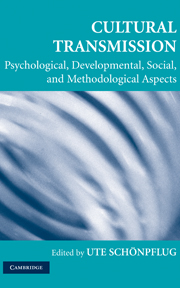Book contents
- Frontmatter
- Contents
- Foreword
- Contributors
- 1 Introduction to Cultural Transmission: Psychological, Developmental, Social, and Methodological Aspects
- 2 Theory and Research in Cultural Transmission: A Short History
- PART ONE EVOLUTIONARY PERSPECTIVE
- PART TWO CROSS-CULTURAL PERSPECTIVE
- PART THREE INTRACULTURAL VARIATIONS
- 14 Intergenerational Transmission of Moral Capital across the Family Life Course
- 15 Similarity of Life Goals in the Family: A Three-Generation Study
- 16 The Intergenerational Transmission of Xenophobia and Rightism in East Germany
- 17 Intergenerational Transmission of Violence
- 18 “Don't Trust Anyone over 25”: Youth Centrism, Intergenerational Transmission of Political Orientations, and Cultural Change
- 19 Value Transmission and Zeitgeist Revisited
- 20 Epilogue: Toward a Model of Cultural Transmission
- Index
- References
18 - “Don't Trust Anyone over 25”: Youth Centrism, Intergenerational Transmission of Political Orientations, and Cultural Change
Published online by Cambridge University Press: 05 June 2012
- Frontmatter
- Contents
- Foreword
- Contributors
- 1 Introduction to Cultural Transmission: Psychological, Developmental, Social, and Methodological Aspects
- 2 Theory and Research in Cultural Transmission: A Short History
- PART ONE EVOLUTIONARY PERSPECTIVE
- PART TWO CROSS-CULTURAL PERSPECTIVE
- PART THREE INTRACULTURAL VARIATIONS
- 14 Intergenerational Transmission of Moral Capital across the Family Life Course
- 15 Similarity of Life Goals in the Family: A Three-Generation Study
- 16 The Intergenerational Transmission of Xenophobia and Rightism in East Germany
- 17 Intergenerational Transmission of Violence
- 18 “Don't Trust Anyone over 25”: Youth Centrism, Intergenerational Transmission of Political Orientations, and Cultural Change
- 19 Value Transmission and Zeitgeist Revisited
- 20 Epilogue: Toward a Model of Cultural Transmission
- Index
- References
Summary
INTRODUCTION
In his seminal work on generational identity and the intergenerational transmission of ideas, Mannheim (1928) already stated that under “normal” social conditions, the ideas of youth resemble those of adults. Only in times of intense social turmoil is it likely that young people start realizing that the conditions they have to face while growing up have changed drastically from those under which their parents grew up and that their worldview should change accordingly. The culturally most sensitive part of a cohort of young people might voice its opinions and create a consciousness that might become the trademark of a larger group of a youth generation, consciously setting itself apart from the habits and ideas of an older generation.
Mannheim (1928) wrote this part of his work in post–World War I Germany, where a demoralized young-adult generation, wary of war and nationalistic slogans, expressed intense dissent with the optimistic bourgeois outlook that had prevailed in the last decades of the 19th century and the first decades of the 20th. The war itself, the socialist revolution attempts of 1918–1919, and the highly unstable social and political climate in the Weimar Republic fostered a generational consciousness among a group of young adults who had left their youth in the trenches of the Great War. To those young men, the future looked bleak and all bourgeois claims of imminent progress and grand visions of Germany's geopolitical prominence, as espoused throughout the countries' educational system, seemed a fraud.
- Type
- Chapter
- Information
- Cultural TransmissionPsychological, Developmental, Social, and Methodological Aspects, pp. 419 - 440Publisher: Cambridge University PressPrint publication year: 2008



